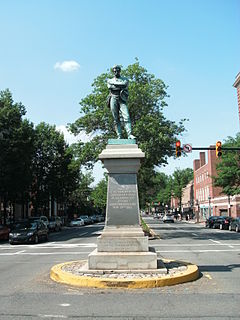 W
WAppomattox is a bronze statue commemorating soldiers from Alexandria, Virginia, who had died while fighting for the Confederacy during the American Civil War. The memorial was located in the center of the intersection of South Washington Street and Prince Street in the Old Town neighborhood of Alexandria.
 W
WArlington House, The Robert E. Lee Memorial, formerly named the Custis-Lee Mansion, is a Greek revival style mansion located in Arlington, Virginia, United States that was once the home of Confederate Army General Robert E. Lee. It overlooks the Potomac River and the National Mall in Washington, D.C. During the American Civil War, the grounds of the mansion were selected as the site of Arlington National Cemetery, in part to ensure that Lee would never again be able to return to his home. The United States has since designated the mansion as a National Memorial. Although the United States Department of the Army controls Arlington National Cemetery, the National Park Service, a component of the United States Department of the Interior, administers Arlington House.
 W
WThe Turner Ashby Monument is a memorial placed in 1898 to mark the place at which Confederate Army Colonel Turner Ashby was killed in the 1862 Battle of Good's Farm. It is located at the end of Turner Ashby Lane in a small privately maintained park that is open to the public. It consists of a granite shaft, its sides finished roughly except for the inscription panel, with a similarly cut pyramidal top. It is set on a limestone base. Its 1898 dedication ceremony was attended by 5,000 people, and typifies emblems of the Lost Cause of the Confederacy.
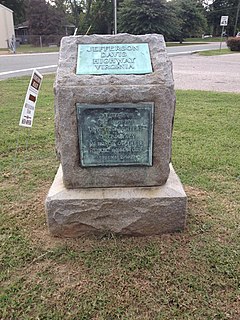 W
WThe Jefferson Davis Highway Marker is a commemorative marker on the Jefferson Davis Highway, in Hanover County, Virginia, near Ashland. It is a 42-inch-high (1.1 m) gray granite stone, with a slanted top, with two bronze plaques. The Jefferson Davis Highway was conceived and marked by the United Daughters of the Confederacy, as a counter to the Lincoln Highway in the north, during 1913–1925. In that era, named highways were being marked as automobile travel increased, and the advent of numbered highways eventually loomed. The marker was placed at the junction of what is now US Route 1 and Cedar Lane, between Richmond and Ashland, in 1927. It has been moved twice: in the 1970s it was moved to accommodate the widening of Route 1, and it was moved across Route 1 in the 1980s.
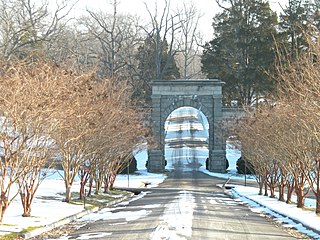 W
WBlandford Cemetery is a historic cemetery located in Petersburg, Virginia, United States. The oldest stone, marking the grave of Richard Yarbrough, reads 1702. It is located adjacent to the People's Memorial Cemetery, a historic African-American cemetery.
 W
WThe Blandford Church is the oldest building in Petersburg, Virginia whose history is well documented. It is at the highest point in the city, atop Well's Hill. It is today (2019) part of a memorial to Southern soldiers who died during the Civil War. It is adjacent to Blandford Cemetery, which is much more important historically than the church. The Blandford Cemetery did not exist until after the church building had been abandoned, in the early 1800s, and the land purchased by the city to use as a cemetery.
 W
WThe Brook Road Marker, Jefferson Davis Highway is a commemorative marker on the Jefferson Davis Highway, in Henrico County, Virginia, outside of Richmond, Virginia. The Jefferson Davis Highway was conceived and marked by the United Daughters of the Confederacy, as a counter to the Lincoln Highway in the north, during 1913–1925. In that era, named highways were being marked as automobile travel increased, and the advent of numbered highways eventually loomed. The marker was placed in North Richmond Brook Road, south of Hilliard Road, in 1927. It is one of the earliest, out of 16, that were placed to mark the highway in Virginia by the United Daughters of the Confederacy. It is a 42-inch-high (1.1 m) gray granite stone, with a slanted top, and a bronze plaque.
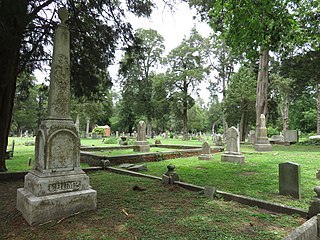 W
WCedar Hill Cemetery, also known as Green Hill Cemetery, is a historic cemetery and national historic district located at Suffolk, Virginia. The district encompasses four contributing structures, one contributing site, and three contributing objects in the a city-owned, 25-acre, public cemetery dating to 1802. Grave markers within the cemetery date from the early 19th century to the present day. This cemetery is a representative example of public cemetery planning and funerary artwork found in southeast Virginia and Suffolk. The contributing structures include the Darden (1938), Hosier, Hill (1933) and Brewer-Godwin mausoleums and the contributing objects include the Confederate Monument (1889) and World War I Monument.
 W
WThe Confederate Monument in Portsmouth, Virginia, was built between 1876 and 1881. It was listed on the National Register of Historic Places (NRHP) in 1997.
 W
WThe Confederate Memorial is a memorial in Arlington National Cemetery in Arlington County, Virginia, in the United States, that commemorates members of the armed forces of the Confederate States of America who died during the American Civil War. Authorized in March 1906, former Confederate soldier and sculptor Moses Jacob Ezekiel was commissioned by the United Daughters of the Confederacy in November 1910 to design the memorial. It was unveiled by President Woodrow Wilson on June 4, 1914.
 W
WFalling Creek UDC Jefferson Davis Highway Marker is a historic stone highway marker located near Richmond, in Chesterfield County, Virginia. It was erected in 1933, and is one of sixteen erected by the United Daughters of the Confederacy in Virginia along the Jefferson Davis Highway between 1927 and 1946. The marker is a gray granite boulder with rough-cut edges. The stone is engraved with the text “ERECTED BY THE FIRST DISTRICT VIRGINIA DIVISION UNITED DAUGHTERS OF THE CONFEDERACY 1933.” It is located in a wayside established in 1934, that provides access to the Bridge at Falling Creek. It was the first highway wayside park in Virginia.
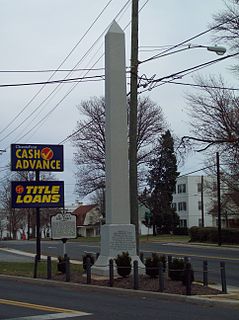 W
WThe Fort Early and Jubal Early Monument was started in the early 1900s, and consists of the remains of an American Civil War fort and monument located on a 1.29-acre (5,200 m2) site at Lynchburg, Virginia. Confederate forces under the command of Lt. Gen. Jubal Early constructed the roughly square earthen fort in June 1864 as part of the outer defenses of Lynchburg as the Union Army of West Virginia, under Maj. Gen. David Hunter, advanced from the north and west in an attempt to capture the city during the Battle of Lynchburg. It is the only section of the Lynchburg defenses still in existence.
 W
WElliott Grays Marker-Jefferson Davis Highway is a historic route marker located on U.S. Route 1, or Jefferson Davis Highway, in Richmond, Virginia. It was erected in 1929, by the United Daughters of the Confederacy. It is one of 16 erected in Virginia along the Jefferson Davis Highway between 1927 and 1947. The marker is an inscribed granite slab with smooth flat faces and rough-cut edges. It measures 47 inches tall, 25 inches wide and 12 inches thick. The stone is engraved with the text "Jefferson Davis Highway This tree marks the site of Battery 17 of the inner defenses of Richmond, 1862-65, and is planted in soil taken from battlefields A memorial to Confederate Soldiers by the Elliott Grays Chapter U.D.C. 1929."
 W
WThe Howitzer Monument was installed in Richmond, Virginia, in the United States. It commemorated the Richmond Howitzers, a Confederate artillery unit. The statue was created by Caspar Buberl. It was located on Virginia Commonwealth University's Monroe Park campus.
 W
WThe Stonewall Jackson Monument, is a partially deconstructed monument with a remaining granite pedestal that previously contained an equestrian statue installed along Richmond, Virginia's Monument Avenue, in the United States.
 W
WThomas Jonathan Jackson is a historic bronze equestrian sculpture of Stonewall Jackson located at Charlottesville, Virginia. It was sculpted by Charles Keck (1875-1951), and was the third of four works commissioned from members of the National Sculpture Society by Paul Goodloe McIntire. The sculpture was the second of three McIntire gave to the city during the years 1919 to 1924. It was erected in 1921. All four sculptures are located in Charlottesville.
 W
WKing and Queen Courthouse Green Historic District is a national historic district located at King and Queen Court House, near Shacklefords, King and Queen County, Virginia. It encompasses eight contributing buildings, seven contributing structures, and two contributing objects in the county seat of King and Queen County. The district includes a small courthouse compound with a courthouse, clerk's office, and county jail, a granite monument and brick wall, a hotel / tavern building, a school, a specialty store building, and a residence on the site of another hotel and tavern.
 W
WLee Chapel is a National Historic Landmark in Lexington, Virginia, on the campus of Washington and Lee University. It was constructed during 1867–68 at the request of Robert E. Lee, who was President of the University at the time, and after whom the building is named. The Victorian brick architectural design was probably the work of his son, George Washington Custis Lee, with details contributed by Col. Thomas Williamson, an architect and professor of engineering at the neighboring Virginia Military Institute. General Lee, along with much of the rest of the Lexington community, attended church services at Grace Episcopal Church, a hundred yards south, at the edge of the college campus.
 W
WThe Robert E. Lee Monument in Richmond, Virginia, was the first installation on Monument Avenue in 1890, where it remained the largest statue on the site. Since early July 2020, it is the last Confederate monument on the Avenue. Removal of the statue is currently blocked, pending an October 19 trial.
 W
WThe Robert Edward Lee is an outdoor bronze equestrian statue of Robert E. Lee and his horse Traveller. Commissioned in 1917 and dedicated in 1924, it is located in Charlottesville, Virginia's Market Street Park in the Charlottesville and Albemarle County Courthouse Historic District. It was listed on the National Register of Historic Places in 1997.
 W
WMaury Street Marker, Jefferson Davis Highway is a historic route marker located on U.S. Route 1, or Jefferson Davis Highway, in Richmond, Virginia. It was erected in 1935, by the United Daughters of the Confederacy (UDC). It is one of 16 erected in Virginia along the Jefferson Davis Highway between 1927 and 1947. The marker is an inscribed granite slab with smooth flat faces and rough-cut edges. It measures 45 inches (110 cm) tall, 25 inches (64 cm) wide and 9 inches (23 cm) thick. The stone is engraved with the text "Jefferson Davis Highway Erected by Elliott Grays Chapter United Daughters of the Confederacy 1935".
 W
WThe Memorial to the Women of the Confederacy, also known as the U.D.C. Memorial Building, is a historic building located in Richmond, Virginia, that serves as the national headquarters of the United Daughters of the Confederacy. It was listed on the U.S. National Register of Historic Places in 2008. The building is open to the public on scheduled days. The building was set on fire on May 30, 2020, during the George Floyd protests.
 W
WThe Norfolk Confederate Monument was a Confederate memorial in front of the Norfolk Southern Museum in Norfolk, Virginia, United States. The monument was removed in June 2020.
 W
WThe Oak Grove Cemetery, formerly known as the Stonewall Jackson Memorial Cemetery and the Presbyterian Cemetery, is located on South Main Street in downtown Lexington, Virginia, less than a mile from the campus of the Virginia Military Institute. The cemetery was named after Stonewall Jackson, who was buried here in 1863. Also buried here are 144 Confederate veterans, two Governors of Virginia, and Margaret Junkin Preston, the "Poet Laureate of the Confederacy".
 W
WProctor Creek, Jefferson Davis Highway Marker is a historic stone highway marker located near Richmond, in Chesterfield County, Virginia. It was erected in 1931, and is one of sixteen erected by the United Daughters of the Confederacy in Virginia along the Jefferson Davis Highway between 1927 and 1946. The marker is a gray granite boulder with rough-cut edges. The stone is engraved with the text "ERECTED BY THE FIFTH DISTRICT VIRGINIA DIVISION UNITED DAUGHTERS OF THE CONFEDERACY 1931."
 W
WStonewall Cemetery is a subsection of Mount Hebron Cemetery in Winchester, Virginia, established in 1866 for 2,575 Confederate soldiers who died in battle or in the hospitals in and around the Winchester area. A monument over the mass grave of more than 800 unknown Confederate soldiers is at the center of the cemetery, and the plots are divided by the home states of the fallen soldiers within.
 W
WVirginia Military Institute (VMI) is a public military college in Lexington, Virginia. It was founded in 1839 and is the first public Senior Military College in the United States. In keeping with its founding principles and unlike any other Senior Military College in the United States, VMI enrolls cadets only and awards bachelor's degrees exclusively. VMI offers its students, all of whom are cadets, strict military discipline combined with a physically and academically demanding environment. The Institute grants degrees in 14 disciplines in engineering, science, and the liberal arts, and all VMI students are required to participate in ROTC.